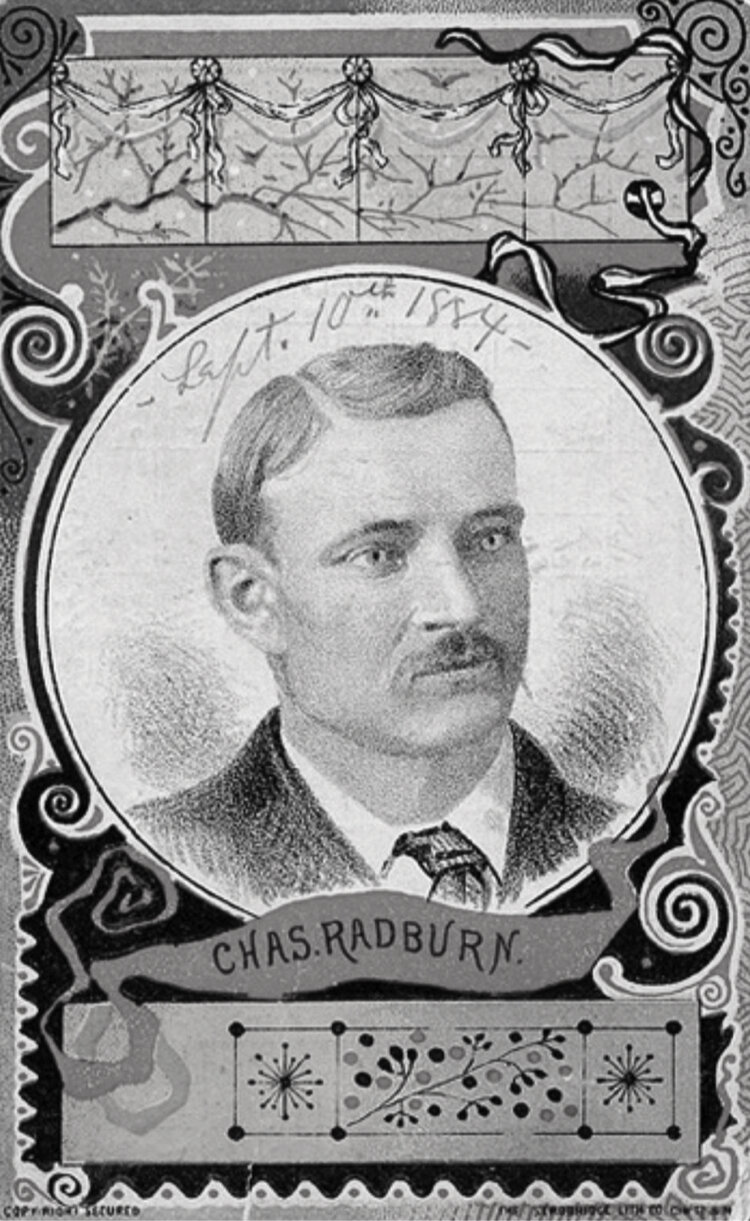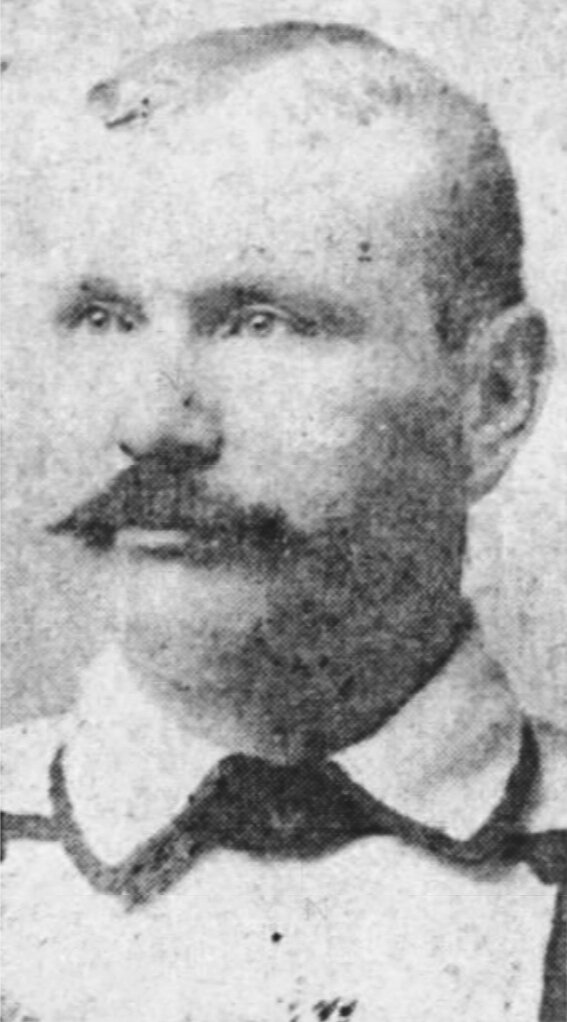Born: July 14, 1851, Worcester, MA
Died: November 1, 1917, Hartford, CT
Buried: Mount St. Benedict Cemetery, Bloomfield, CT
Among all native sons of Hartford, Connecticut, Stephen A. Brady was the city’s greatest 19th century ballplayer. His professional career spanned sixteen seasons during America’s Gilded Age. Known as a heavy hitter who delivered in clutch situations, he was a reliable utility player. Although his primary position was right field, he also played center field, as well as first, second, and third base. As a member of Hartford’s first Major League club in 1874, Brady was a hometown hero. He went on to captain the New York Metropolitans to multiple championships, including the first world championship in 1884.

Steve Brady was born in Worcester, Massachusetts, to Christopher and Mary McDonald Brady. Shortly after his birth, the Bradys relocated to Hartford. The Irish-American family lived at 72 Ward Street in the city’s Frog Hollow neighborhood. Young Stephen was one of seven children—four brothers and two sisters—named Jackson, Thomas, Edward, Christopher, Bridget, and Margaret. The Brady brothers were gifted athletes who excelled at the budding National Game.

Brady came of age when baseball was spreading like wildfire across America. The first club in Hartford was organized in 1860 under the name Independent Base Ball Club, followed by the Charter Oak Base Ball Club in 1862. The game grew more popular in parks and pastures among local fans and amateur players as the years pressed on, and a young Steve Brady was there to witness its formation in Hartford. Brady began his amateur baseball career with the Hylas Base Ball Club of Hartford in the late 1860s.

He then joined the Jefferson Base Ball Club, where his brother Jackson served as catcher. In the summer of 1871, Brady was appointed Vice President of the Jefferson club, which played at Frog Hollow’s Ward Street Grounds. By 1874, he captained the Hartford Amateurs, a citywide team formerly known as the Stars. At 20, Brady led them in games against Yale College, Trinity College, Waterbury, New Britain, Meriden, and Middletown, alongside future Major Leaguers, John “Hartford Jack” Farrell at second base, Bill Tobin at first base, and Charlie Daniels as pitcher.

As Brady led Hartford’s amateur scene, the city gained a big league team in the National Association. The Hartford Base Ball Association was incorporated on March 21, 1874, when the city’s population was about 40,000. Shares were priced at $25 each, raising $5,000 in capital. Key investors, or ‘subscribers,’ included Ben Douglas Jr., the club’s organizer and top shareholder; Morgan G. Bulkeley, a prominent Connecticut politician, Civil War veteran, Aetna executive, and the first President of the National League; and Gershom B. Hubbell, President of the Hartford Base Ball Club and former captain of the Charter Oak Base Ball Club. The team would later be known as the Hartford Dark Blues.

Meanwhile, Brady and the Hartford Amateurs competed for local prestige and recognition. On July 14, 1874, the Amateurs faced off against the Dark Blues at the Hartford Grounds, where they suffered a 15-1 defeat. A week later, Lip Pike of the Dark Blues, known as a ‘championship runner,’ challenged Brady to a footrace. Although Brady was a skilled runner, Pike outpaced him. However, the professional club was impressed by Brady’s abilities and athleticism.

When Hartford Dark Blues shortstop Tommy Barlow fell ill, reportedly due to a morphine addiction, the club brought in Steve Brady. The hometown favorite made his debut with the Dark Blues on July 22, 1874, against an amateur club, the Clippers of Bristol, Connecticut. Brady played third base, while the team’s president, Gershom Hubbell, occupied right field. Hartford overwhelmed Bristol with a 36-0 victory, securing Brady a roster spot. He finished the season with 27 games, 37 hits, and a .316 batting average.


The following year, Brady appeared in only one game with the Dark Blues before joining the original Washington Nationals. Unfortunately, his performance with Washington in 1875 was disappointing; in 21 games, he managed only a .143 batting average. When the Nationals disbanded, he was dismissed. He regained good form the next year with Billy Arnold’s Providence club, champions of the New England League. His comeback continued in 1877 with the International Association’s Rochester team, where he excelled, hitting .373. Brady went on to play professionally with Springfield, the powerhouse Worcester Grays, and the Rochester Hop Bitters.

When Rochester forfeited their remaining games in September 1880, Brady and a few teammates were recruited by the newly formed Metropolitan Base Ball Club of New York. At 29, Brady was a respected veteran and became captain of the Metropolitans. The club’s owner, John B. Day, was another Connecticut native living in New York. Their manager, Hall of Famer Jim Mutrie, was known as the winningest coach in vintage baseball. Brady’s Metropolitan teammates included two fellow Nutmeggers, Jerry Dorgan of Meriden and Jack Leary of New Haven.

The Metropolitans operated as an independent club from 1880 to 1882 and were the first professional team to play home games in Manhattan. The “Mets” hosted opponents at the original Polo Grounds on the Upper West Side (110th Street between Fifth and Sixth Avenues). In the inaugural game on September 29, 1880, Brady became the first player to step into the batter’s box as the leadoff man. Over 20,000 fans watched as the New York defeated the Washington Nationals 4-2.

With Brady in right field, the Metropolitans became one of the nation’s top clubs within two years. They joined the American Association in 1883, finishing fourth with 54 wins, 42 losses, and one tie against the Louisville Eclipse. In 1884, Brady and the Mets claimed the American Association title with a 75-32-5 record. That year, the very first World Series was held after Manager Mutrie of the Mets challenged Frank Bancroft, manager of the National League champion Providence Grays, to a three-game series.

This first World Series was played on October 22, 24 and 25, at the Polo Grounds. On the mound for the Grays was the legendary Charles ‘Old Hoss’ Radbourn, while Tim Keefe pitched for the Metropolitans. The Grays won all three games: 6-0, 3-1, and 11-2. Radbourn’s dominance proved too much for Brady and the Mets. Game one went the full nine innings, while game two was called after seven innings due to darkness. The third game, though inconsequential, was played for revenue, but only about 300 spectators attended due to cold weather.

Although the Metropolitans lost the first World Series, Brady’s fame reached its peak during the 1884 season. He was a celebrated figure in Hartford, where he spent his winters with his family. His brothers, Jackson and Thomas, were key players for the Jefferson Base Ball Club, Hartford’s top amateur team. When Brady returned to New York for the 1885 season, he was named captain again. The Mets finished in seventh place in the American Association, with Brady batting .290.

In 1886, Brady reported to training camp out of shape, and the Mets finished seventh out of eight teams. With his skills diminishing, Brady breifly returned home. He became first baseman and captain of the 1887 Hartford club. The Eastern League team reunited Brady with Charlie Daniels, who managed, Jerry Dorgan in center field, and John ‘Hartford Jack’ Farrell at second base. However, the Hartfords disbanded in August of 1887, and Brady was acquired by a team in Jersey City, New Jersey.

In a new endeavor, Brady became part-owner of an ice skating rink in Brooklyn and took on the role of head of the Brooklyn Ice Polo Club. Teaming up with former Mets manager Jim Mutrie, they aimed to establish a national ice polo league in the fall of 1887. Ice polo, the forerunner to ice hockey, was quickly gaining popularity in the northeastern United States. Brady and Mutrie traveled across the country seeking players and sponsors, but the venture ultimately proved financially unsuccessful.

Brady, both an entrepreneur and sportsman, resumed baseball in 1888 with the Jersey City Skeeters of the Central League, playing first base at 36 years old. After an uneventful season, he retired as a player and applied to become an umpire in the Atlantic Association, a position he secured in June 1889. However, his umpiring stint was short-lived, as he was replaced less than a month later. Brady then transitioned to work as a saloon keeper in New York City.

By 1892, he had moved back to Hartford and married Mary A. Begley from New Britain. He joined the Hartford baseball club, competing in the Connecticut State League alongside ex-major leaguers like Mickey Welch, Ed Beecher and John M. Henry. It would be his final season in organized ball. Upon retiring, Brady and his brothers founded a successful bottling company in Hartford, Brady Brothers, which produced stone and glass bottles filled with mineral water and soda.

Brady made his final recorded appearance on a baseball field in the summer of 1898, when his team of wine clerks faced a Hartford Police nine. His fingers were described as “twisted and knotted,” from a lifetime of fielding in an era without proper hand protection. He became an active member of the Hartford Elks Lodge and the Ancient Order of Hibernians, with whom he engaged in various charitable efforts. On November 17, 1917, Stephen A. Brady passed away at age 66 in his birthplace at 72 Ward Street. His brother, John ‘Jackson’ Brady, continued the family business as President of Brady Bros.






Sources
- Hartford Courant database on Newspapers.com
- Baseball-Reference.com






































